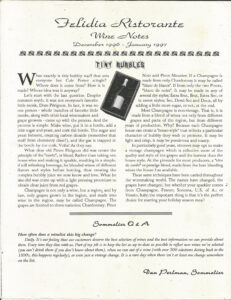 Felidia Ristorante
Felidia Ristorante
Wine Notes
December 1996 – January 1997
Tiny Bubbles
What exactly is this bubbly stuff that set everyone but Cole Porter a tingle? Where does it come from? How is it made? Whose idea was it anyway?
Let’s start with the last question. Despite common myth, it was not everyone’s favorite little monk, Dom Pérignon. In fact, it was no one person – whole bunches of favorite little monks, along with other local winemakers and grape growers – came up with the process. And the process is simple. Make wine, put it in a bottle, add a little sugar and yeast, and cork the bottle. The sugar and yeast ferment, creating carbon dioxide (remember that stuff from chemistry class?), and the gas is trapped in the bottle by the cork. Voila! As they say.
What dear old Pierre Pérignon did was create the principle of the “cuvée”, or blend. Rather than taking one house wine and making it sparkle, resulting in a simple, if still refreshing beverage, he blended wines of different flavors and styles before bottling, thus creating the complex bubbly juice that we now know and love. What he also did was come up with a light pressing procedure to obtain clear juice from red grapes.
Champagne is not only a wine, but a region, and by law, only grapes grown in the region, and made into wine in the region, may be called Champagne. The grapes are limited to three varieties; Chardonnay, Pinot Noir and Pinot Meunier. If a Champagne is made from only Chardonnay it may be called “blanc de blancs”. If from only the two Pinots, “blanc de noirs”. It may be made in any of several dry styles; Extra Brut, Brut, Extra Sec, or in sweet styles; Sec, Demi-Sec and Doux, all by adding a little more sugar, or not, at the end.
Most Champagne is non-vintage. That is, it is made from a blend of wines not only from different grapes and parts of the region, but from different years of production. Why? Because each Champagne house can create a “house-style” that reflects a particular character of bubbly they wish to promote. It may be light and crisp, it may be ponderous and toasty.
In particularly good years, vintners may opt to make a vintage champagne which is reflective more of the quality and style of the grapes and the harvest than the house style. At the pinnacle for most producers, a “tête de cuvée” or prestige blend, made from the best blending wines the house has available.
These same techniques have been carried throughout the winemaking world. The names have changed, the grapes have changed, but whether your sparkler comes from Champagne, France; Sonoma, U.S. of A.; or Veneto, Italy; the important thing is that it’s the perfect choice for starting your holiday season meal!
Sommelier Q&A
How often does a winelist this big change?
Daily. It’s our feeling that our customers deserve the best selection of wines and the best information we can provide about them. Every time they dine with us. Part of my job is to keep the list as up-to-date as possible to reflect new wines we’ve selected (you can’t drink them if you don’t know about them), when we run out of a wine (with over 500 selections dating back to the 1800s, this happens regularly, or even just a vintage change. It is a rare day when there isn’t at least one change somewhere on the list.